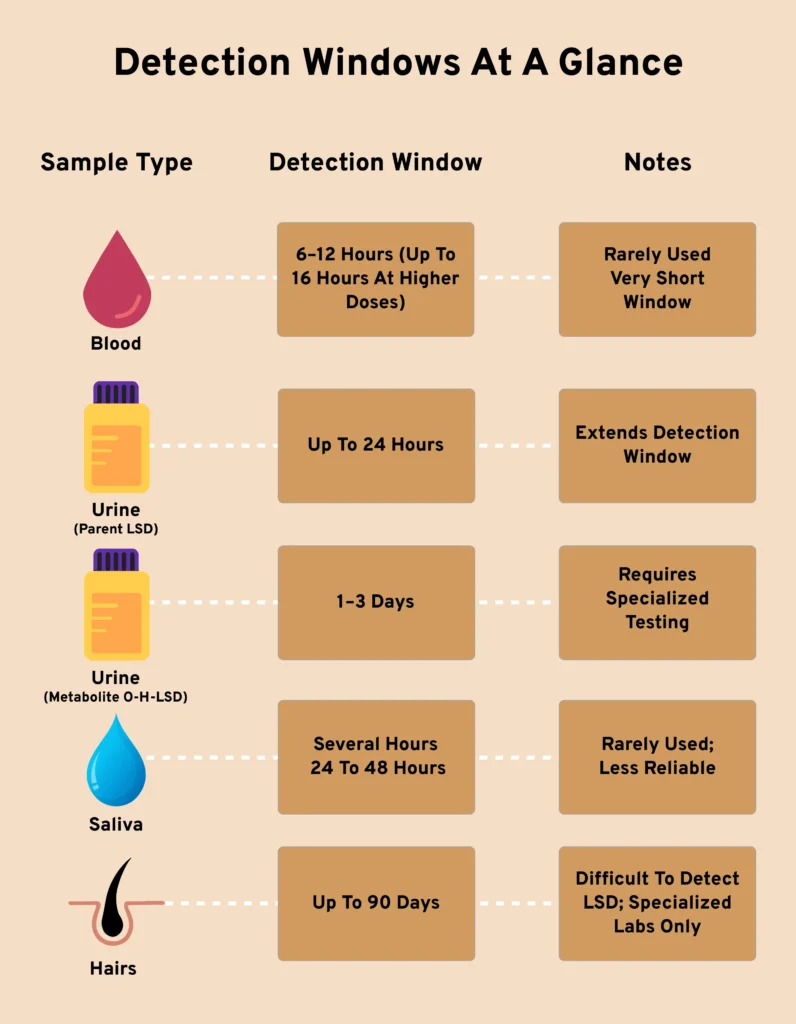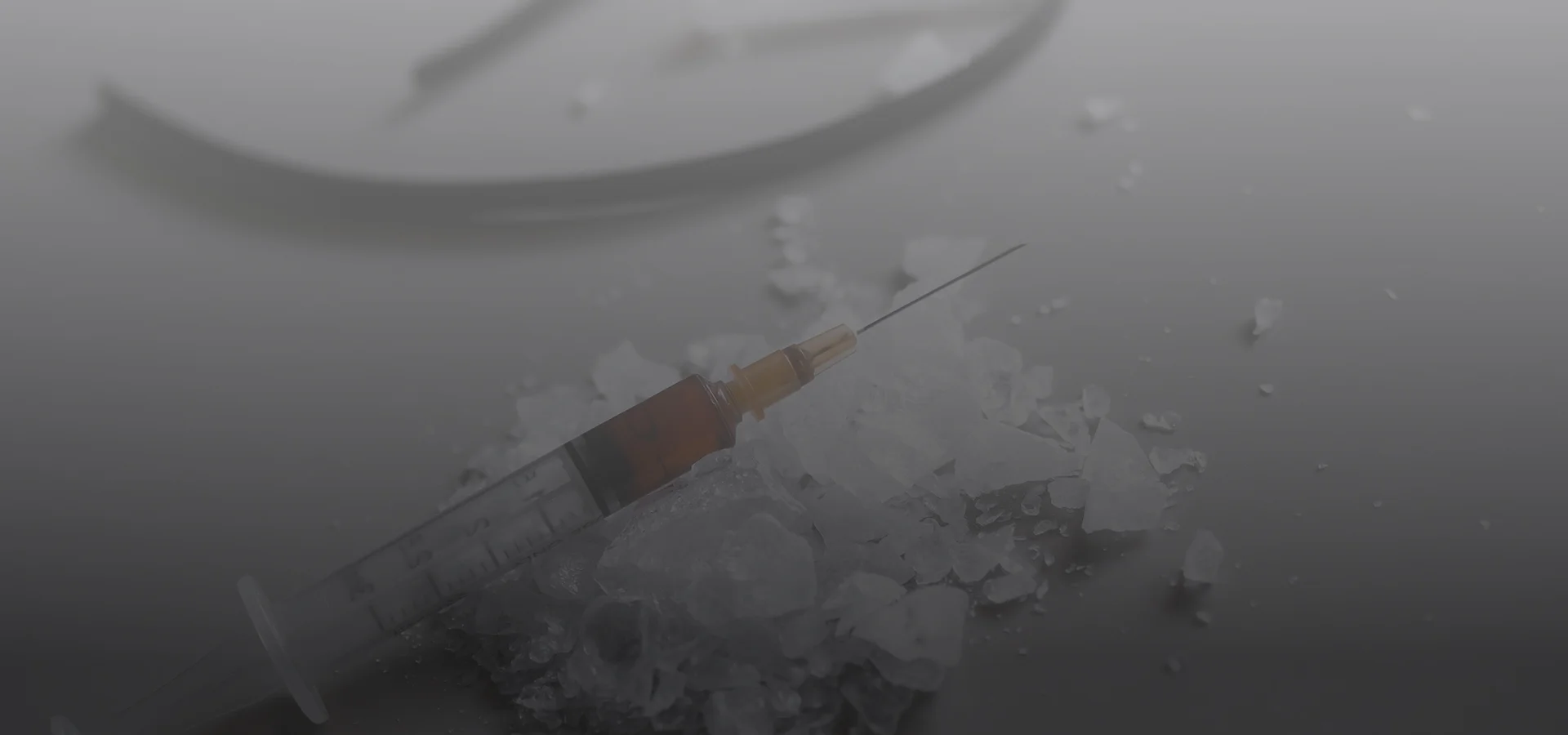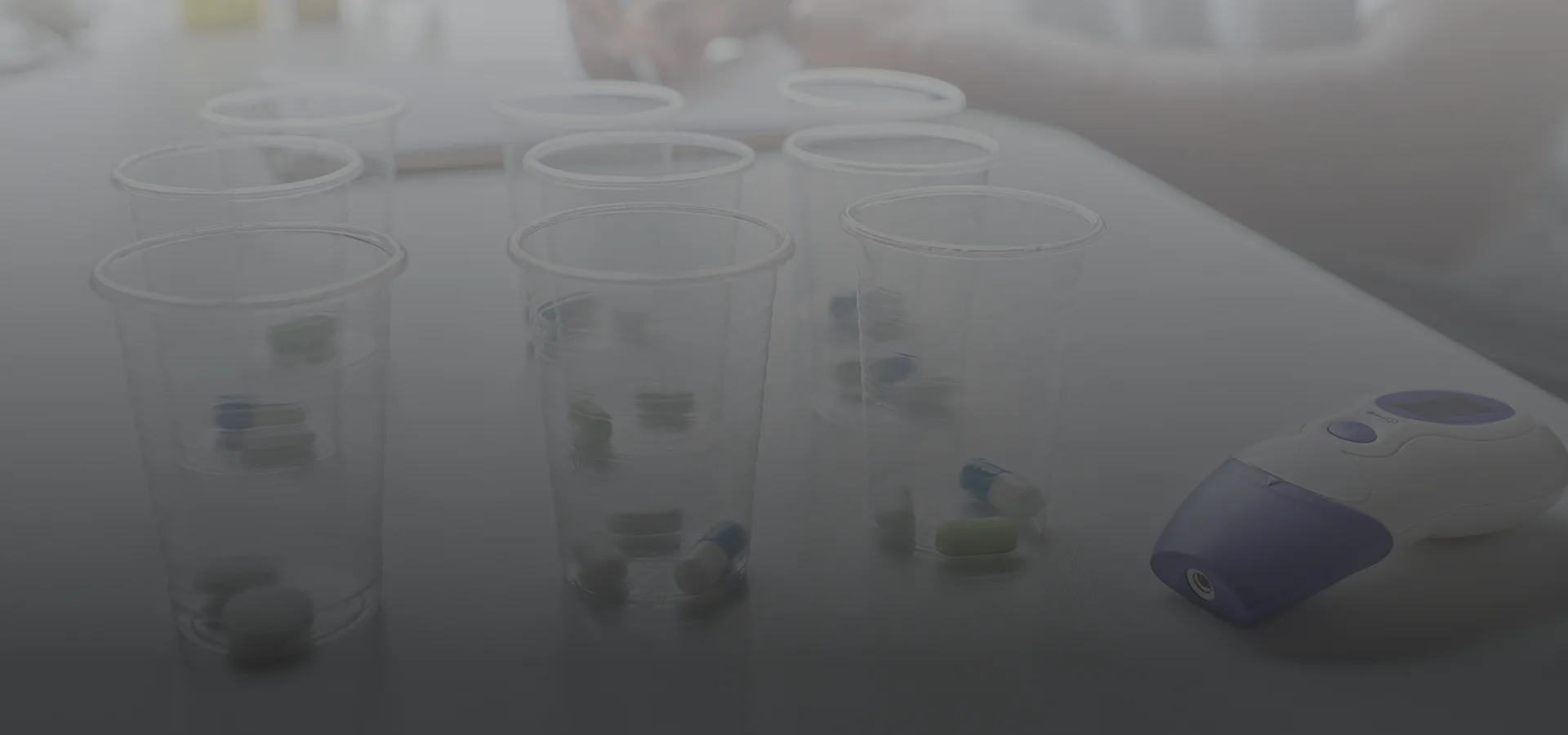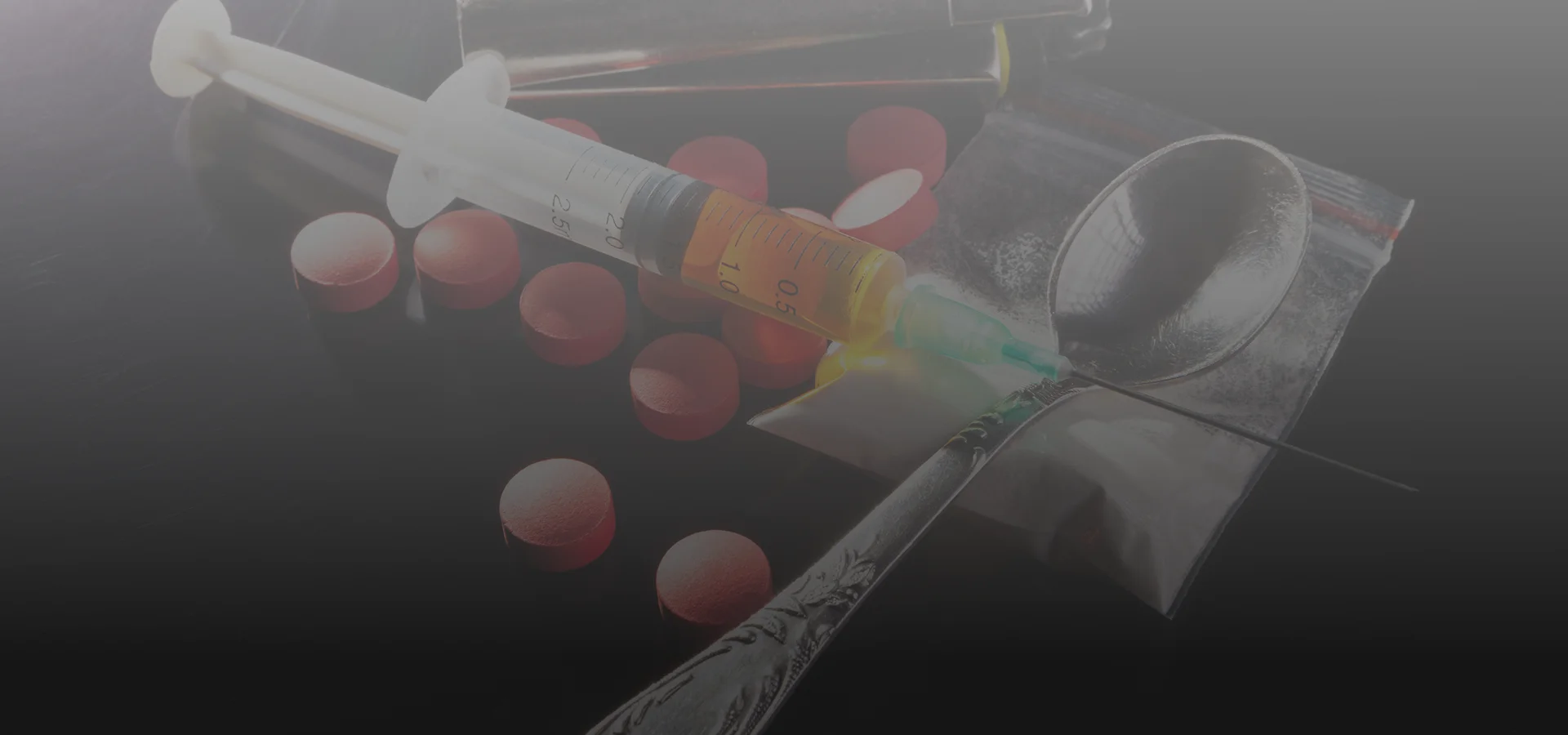Lysergic acid diethylamide (LSD), more commonly known as acid, is one of the most potent hallucinogens in the world.
Even in microgram doses, it can profoundly alter perception, mood, and thought. While the psychedelic trip usually lasts only a few hours, many people are left asking: How long does LSD stay in your system?
The answer isn’t as simple as you might think. LSD breaks down quickly, but traces of the drug and its metabolites can linger in the body for hours to days — and in some cases, even months when looking at hair samples.
The actual detection window depends on factors such as test type, metabolism, body mass, and dosage.
In this comprehensive guide, we’ll cover:
- Exactly how long LSD stays in your blood, urine, saliva, and hair.
- Why myths about LSD “staying in the spine” or “forever in your system” are false.
- Which factors influence LSD detection time.
- Why LSD often doesn’t show up on routine drug tests.
- Frequently asked questions about LSD detection.
If you or a loved one is struggling with substance use or are worried about drug testing, visit Drugs Rehab FL for professional guidance and treatment resources.

Why You Should Know How Long LSD Stays in Your Body
There’s a lot of misinformation online about LSD. Some people believe it’s undetectable because the body metabolizes it quickly. Others fear that LSD “stays in your system forever” or “hides in your spinal fluid.” Both ideas are misleading.
Understanding how long acid stays in your system is important if:
- You’re undergoing a drug test for work, school, or legal reasons.
- You’ve used LSD and want to know when it will leave your body.
- You want to separate fact from fiction about drug detection.
- You’re concerned about the short- and long-term effects of hallucinogens.
By knowing the truth about LSD’s metabolism and detection windows, you can make more informed choices and avoid the myths that surround psychedelic substances.
LSD in the Body: What You Need to Know
Let’s start with the basics.
- NIDA points out that, Half-life of LSD: Roughly 3.6 to 5 hours (this is how long it takes for the concentration of LSD in your blood to reduce by half).
- Peak levels in blood: Around 1.5 to 2 hours after ingestion.
- Excretion: Only 1% of LSD is eliminated unchanged in urine; the rest is broken down into metabolites such as 2-oxo-3-hydroxy-LSD (O-H-LSD), said by Healthline
- Detectability depends on: The sample tested (blood, urine, saliva, hair), the sensitivity of the test, and individual biology.
This means LSD leaves the bloodstream quickly, but traces of its metabolites can stay in your system for longer, especially in urine or hair samples.
How Long Does Acid Stay in Your Blood?
Blood tests can detect LSD only for a short period:
- Typical detection window: 6–12 hours after ingestion.
- Extended detection by Medical News Today: Up to 16 hours at higher doses or with very sensitive testing methods such as LC-MS/MS (liquid chromatography–mass spectrometry).
Because LSD is metabolized rapidly by the liver, blood testing is rarely used for workplace or medical screenings. It is more common in clinical research or forensic investigations where immediate detection is necessary.
How Long Does Acid Stay in Your Urine?
Urine testing is the most widely used method for drug screening, but LSD presents unique challenges.
- Parent LSD (unchanged): Detectable for up to 24 hours in urine with advanced laboratory methods.
- According to VeryWellMind, Metabolite O-H-LSD: Can be detectable for 1–3 days depending on dose, individual metabolism, and test sensitivity.
It’s important to note: most routine workplace urine drug panels do not test for LSD. A specific request must be made for LSD screening, and specialized technology such as UHPLC-MS/MS is required.
How Long Does LSD Stay in Your Saliva?
Saliva tests for LSD are not commonly used but can sometimes detect recent use.
- Typical range: A few hours up to about 24 hours.
- Extended detection: Occasionally up to 48 hours, but this is rare, American Addiction Centers points out.
Because LSD concentrations in saliva are very low and variable, saliva testing is less reliable compared to urine or blood.
How Long Does LSD Stay in Your Hair?
Hair testing provides the longest potential detection window for LSD:
- Typical claim: Up to 90 days, sometimes longer depending on hair length.
However, LSD is consumed in microgram doses, which makes it much harder to detect in hair compared to other substances like cocaine or cannabis. A negative hair test does not always mean a person hasn’t used LSD.
Only highly specialized laboratories are capable of detecting LSD in hair with certainty.
Does LSD Stay in Your System Forever?
One of the most common myths is that LSD “stays in your spine” or remains in your body forever. This is not true.
- LSD is metabolized and eliminated within days.
- What can persist are psychological aftereffects such as flashbacks or Hallucinogen Persisting Perception Disorder (HPPD).
- These effects are neurological, not caused by LSD being physically present in the body.
So while LSD itself does not stay in your system forever, the experiences and aftereffects of its use can sometimes linger.
Factors That Affect How Long LSD Stays in the Body
Not everyone clears LSD at the same rate. Multiple factors affect detection:
Metabolism
Faster metabolisms process LSD more quickly, leading to shorter detection times.
Age
Younger individuals usually clear substances faster than older adults due to stronger liver and kidney function.
Body Mass (BMI)
While LSD is not highly fat-soluble, overall body composition and weight may still play a minor role in distribution and elimination.
Dose and Frequency of Use
- High doses remain detectable for longer.
- Frequent users may show metabolites slightly longer compared to one-time users.
Liver and Kidney Health
Since LSD is processed by the liver and excreted by the kidneys, impaired organ function can slow clearance.
Hydration Levels
Dehydration slows excretion, while proper hydration may help the body eliminate metabolites faster.
Timing of the Test
The closer a test is taken to ingestion, the more likely LSD or its metabolites will be detected.
Type of Test
- Routine workplace tests (5-panel or 10-panel): Do not include LSD.
- Advanced lab tests (LC-MS/MS, UHPLC): Required for accurate LSD detection.
Parent LSD vs Metabolites
- Parent LSD clears within about 24 hours.
- Metabolite O-H-LSD can extend urine detection to up to 3 days.
Cross-Reactivity and Test Sensitivity
Some drug tests may confuse LSD with structurally similar compounds, or simply fail to detect it if sensitivity is too low.
Conclusion
So, how long does LSD stay in your system?
- In blood, LSD is detectable for only a few hours.
- In urine, parent LSD may be seen for up to 24 hours, while metabolites can last 1–3 days.
- In saliva, the window is short — usually under 48 hours.
- In hair, traces may remain up to 90 days, though reliability is limited.
The exact detection window depends on dose, metabolism, health, and the type of test used. LSD does not stay in the body forever, but specialized labs can sometimes find evidence of use days or even months after ingestion.
A Healthier Future Starts With One Step
Take control of your well-being today. Our team is here to guide you toward the support and care you need.
How long does acid stay in your system?
LSD itself is cleared within hours, but metabolites can be detected for up to 3 days in urine. Hair samples may reflect LSD use for up to 90 days.
How long does acid stay in your blood?
Typically 6–12 hours, and up to 16 hours at high doses with advanced testing.
How long does acid stay in your urine?
LSD clears quickly, but metabolites like O-H-LSD can extend the urine detection window to 1–3 days.
Does LSD stay in your system forever?
No. LSD does not stay in your system forever. Flashbacks or HPPD are psychological effects, not lingering drug.
Can LSD show up on a routine drug test?
No. Most standard workplace drug tests do not screen for LSD. Specialized tests are required.
How long does acid stay in your pee?
LSD can usually be detected in urine for up to 1–3 days after use. In rare cases or with heavy use, small traces may linger slightly longer. However, most standard drug tests do not screen for LSD unless specifically ordered.
How long does LSD stay in saliva?
In saliva, LSD can be detected for 8–24 hours depending on dose and metabolism. Saliva tests are less common but may be used in research or forensic settings.
How long does LSD stay in hair?
Hair tests provide the longest detection window. LSD can be detected in hair follicles for up to 90 days or longer. However, these tests are expensive, uncommon, and not typically used outside legal or specialized cases.
Can LSD show up on a drug test?
Most standard workplace drug panels (like 5-panel or 10-panel tests) do not include LSD. It requires special, expensive testing methods. That’s why it is rarely detected unless specifically being tested for.
How long does acid stay in your body compared to other drugs?
Compared to many drugs, LSD clears the system relatively quickly:
LSD: 1–3 days in urine
Cocaine: 2–4 days in urine
Marijuana (THC): up to 30 days in urine (chronic use)
MDMA (Ecstasy): 2–4 days in urine
This makes LSD harder to detect than substances that linger in fat cells.


